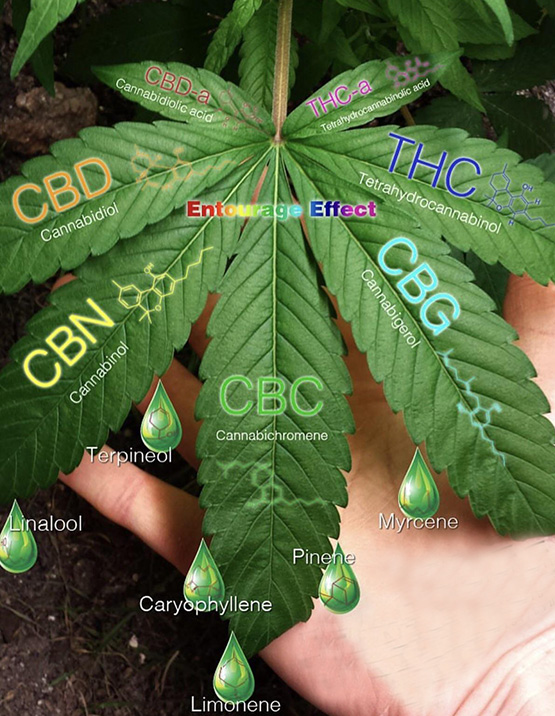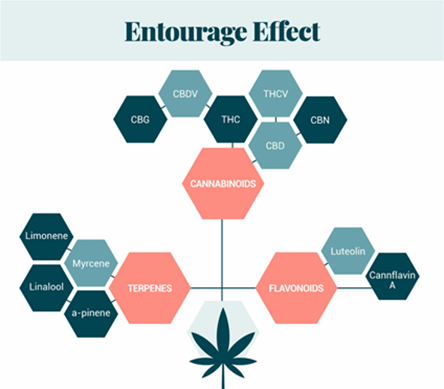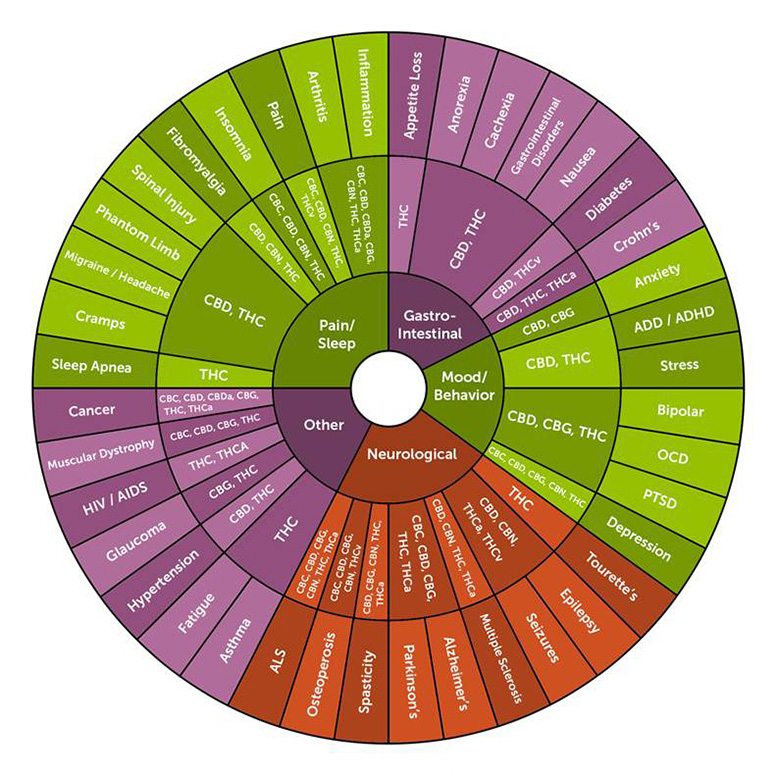Entourage Effect
A large part of alternative medicine revolves around using the entire plant for medicinal purposes rather than isolating or producing the active ingredient synthetically.
Medical substances appear to be more effective in their whole and natural state, as used for thousands of years in ancient healing arts such as Ayurveda and Traditional Chinese Medicine.
This phenomenon, called the entourage effect, results when the many components within the cannabis plant interact with the human body to produce a stronger influence than any one of those components alone, a synergistic effect rather than synthetic effect.
Like partnerships, when we combine multiple abilities of compounds in their natural state, we don’t end up with the sum of each part; instead, we get a multiplying effect. The different compounds can amplify each other’s chemistry, making the overall plant more effective in addressing unwanted symptoms.
The entourage effect becomes especially evident when comparing the effects of tetrahydrocannabinol (THC) (the psychoactive component of the cannabis plant) with the effects of using the whole plant.
Over 480 natural components were found within the cannabis plant, of which 144 have been classified as ‘cannabinoids.’” In addition to cannabinoids, the cannabis plant contains other constituents including proteins, amino acids, steroids, terpenes, flavonoids and more.

Particularly, the compound known as Cannabidiol (CBD) modulates the effect of THC on the human body.
Scientific and clinical experimentation has revealed that a cannabis plant which contains far more THC than CBD makes the user feel intoxicated or “high.” Hemp, which contains the inverse ratio (more CBD than THC) can relieve symptoms without the psychoactive effect of marijuana.
However, specially bred cannabis that contains roughly equal amounts of THC and CBD were shown to be the most effective in terms of symptom relief and pain. These findings indicate that the ratio of THC to CBD plays a crucial role in determining the efficacy of the cannabis plant for therapeutic applications. The only way to know which strain best treats a particular condition is to rely on experience.
There are THC and CBD acidic precursors THCA and CBDA. Cannabigerolic acid (CBGA) is the parent molecule from which other cannabinoids are synthesised. There is cannabinol (CBN), a mildly psychoactive cannabinoid found in aged cannabis. Tetrahydrocannabivarin (THCV), a homologue of THC thought to suppress appetite. Cannabidivarin (CBDV) which may have anti-seizure activity. Further research and experiences are required to fully understand how they affect the body.
The plant's 150+ clear bulbous globes ooze aromatic oils called terpenes as well as therapeutic cannabinoids like THC and CBD.
Terpenes are found both in cannabis and in trees, plants, fruits and vegetables. Limonene has anti-anxiety effects, pinene to be antibiotic, linalool both anaesthetic and anticonvulsant, and beta caryophyllene, a powerful anti-inflammatory agent. Then there’s relaxing myrcene.
Cannabis plants also contains flavonoids, giving the yellow pigment in plants. Flavonoids can be antioxidant and antibiotic, and in some cases are even anti-tumoral.
In nature, terpenes act to repel insects, but in humans, their effects are often medicinal, interacting with cell membranes, neuronal and muscle ion channels, neurotransmitter receptors, G‐protein coupled receptors, and enzymes.

When one considers that a single plant contains hundreds of potentially therapeutic molecules, it’s easy to see why scientists are so excited about isolating and using them as the basis for a whole array of future medicines.
However, one meta-analysis comparing isolated and whole plant CBD as a treatment for epilepsy found that whole plant CBD was not only twice as effective as its isolated equivalent, but that lower doses were needed to achieve a therapeutic effect. And it would seem the entourage effect can take much of the credit.
It seems right and fitting that the entourage effect finds its origins in the body’s endocannabinoid system (ECS), which is our internal body system that processes, creates, and breaks down cannabinoids.
Scientists noticed how some closely related metabolites increased the activity of the primary endocannabinoids; thus coining the phrase “the entourage effect.”
It is like a cast of actors in a theater production. THC and CBD are the protagonists, while the rest of the cannabinoids, terpenes, and others, are the supporting cast. Sure, the main actors are impressive, but without the rest of the cast, costume designers, makeup artists, and others, there would be no play.
While the concept of the entourage effect would appear to explain what is experienced in practice by medical cannabis patients, only now are researchers beginning to find hard evidence to explain the phenomenon.
Just recently, other scientists found the whole plant cannabis extract displayed superior anti-tumoral action compared to isolated THC in all three types of breast cancer studied. In order to find out whether terpenes were responsible, they added a “cocktail” to the isolated THC, identical to the terpenes found in the full spectrum extract. However, this did not alter the anti-tumoral activity. Instead, they suggest any changes may be due to low concentrations of CBG and THCA.

Cannabinoids